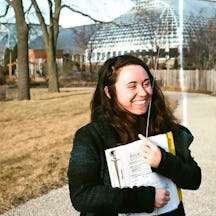Scientists, artists, and philosophers have long turned to the study of anatomy to reveal the hidden workings of human nature. But when you strip away the flesh, what do you find? Anatomists across the centuries have laid bare their own understanding of what it means to be human.
Exposing the secrets of the human body
Words by Amelia Soth
- In pictures

Earth, air, water, fire: these elements make up the human body, according to Avicenna’s foundational 11th-century anatomical treatise. Particularly important was the bodily flow of rarefied air, or spiritus, which suffuses the limbs, directs the intellect, and stirs up the passions. This vital flow acts as a mediator between body and soul.

Avicenna’s ‘Canon’ remained the foremost anatomical text until 1543, when Vesalius published ‘De humani corporis fabrica’, kick-starting the ‘century of anatomy’. In this era, public dissections were all the rage. Medical students and educated lay people – some wearing carnival masks – gathered in candlelit anatomical theatres to watch cadavers of executed criminals being picked apart, to a musical accompaniment.

Alongside the growing interest in public dissection, the Renaissance saw the emergence of the artist-anatomist, who studied the workings of the human body to better depict figures in motion. Michelangelo, for instance, conducted private dissections on bodies awaiting burial. For those with weaker stomachs, realistic wax figures like these were invaluable aids.

Flap anatomy books of the 16th century took an interactive approach to self-discovery, enjoining readers to ‘knowe thyself’ by participating in the act of dissection, paging through the flaps to unveil layer after layer of flesh. The images frequently drew on Christian imagery to demonstrate how God’s creation shaped each intricate detail of the body.

For those with money to burn, there were luxury versions of the home-dissection experience. Miniature eyes like these, with their meticulous craftsmanship and extravagant materials, stared eerily out from many a rich collector’s cabinet of curiosities. This one, a gift for Ferdinando de Medici, can be unscrewed to reveal its inner workings.

Another hot collector’s item? These dissectible ivory figurines, usually depicting pregnant women, were once thought to be reproductive tutorials for newlyweds. However, when male doctors began supplanting midwives as childbirth experts, these figurines may have played a role: physicians collected them as potent symbols of their authority over the workings of the female body.

Seventeenth-century Tibet saw its own anatomical blossoming with ‘The Blue Beryl Treatise’, which interprets anatomy through a Buddhist lens, focusing on the body’s channels rather than layers of flesh. Here, the white soul channel runs along the spine. The channels are part of the body, yet they can also be developed with meditation; thus, reflecting on one’s anatomy was both a scientific and spiritual practice.
In traditional Chinese medicine, health is not the absence of disease, but the presence of a harmonious flow of energy along the body’s meridians. In 1742, the Qianlong Emperor gifted these bronze acupuncture figures to the authors of a new definitive medical text. “Our emperor”, announced the edict accompanying its publication, “sees the people as his children, and wishes that they may all reach long life.”

Nineteenth-century France, likewise, witnessed a growing concern for public health, in which anatomical education played a key role. Anatomist Louis Auzoux invented a technique for making cheap papier-mâché models, but his greatest innovation was turning his factory into a “production Utopia”, where workers were thoroughly trained in the anatomies they constructed. Social reformers asserted that such education would make workers morally upright and upwardly mobile. Auzoux even adopted ‘Nosce te ipsum’ – know thyself – as his company motto.

Not everyone was so high-minded, however. The Victorian era saw the rise of popular anatomical museums, which enticed visitors with the promise of titillation, then shocked them with stomach-churning depictions of oozing syphilis sores. Next, a fast-talking salesman, brandishing some dubious nostrum, would try to convince museum-goers to shell out for a bottle of cure-all or a consultation with an on-premises physician. ‘Knowe thyself’ had become ‘Trust us, we know better than you do’.
About the author
Amelia Soth
Amelia lives in Chicago and writes the column ‘Cabinet of Curiosities’ for JSTOR Daily.

